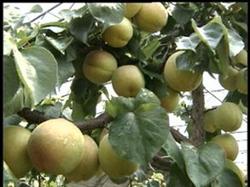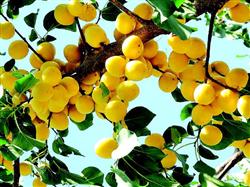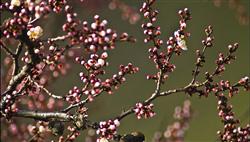Cultivation techniques of Apricot

Cultivated value apricot is a widely cultivated fruit tree in the north of Huaihe River and Qinling Mountains in China. it is resistant to drought, barren and cold, has strong adaptability to soil, and can grow and bear fruit in mountains and hills, sand wasteland and saline-alkali land. The fruit is earlier and the economic life is longer than that of other drupe fruit trees, so it is not only suitable for intensive cultivation, but also suitable for "four sides" planting. The fruit is ripe in early summer, just when the fruit is off-season on the market. Can be fresh, can also be processed into preserved apricot, canned sugar water and other products. Almonds contain a lot of fat and protein and are rich in nutrition. Sweet kernels can be used in the pastry industry or further processed into almond cream and other products; bitter kernels can be used as medicine, with the effects of relieving cough and relieving asthma, moistening intestines and laxative, and is one of the traditional export commodities. Preserved apricot and preserved apricot sauce are also very popular abroad. The main species and varieties of apricot are plants of the subgenus Prunus of Rosaceae, which are closely related to plum. In addition to apricot for economic cultivation, there is also a variety of Li Guang apricot in Northwest China, and the variety of mountain apricot is mostly used as rootstock or kernel. There are wild species such as Liao apricot and Mongolian apricot in Northeast and North China. Apricot is rich in local varieties, which can be divided into fresh food type, processing type, kernel type and kernel type according to its use. Most of the varieties cultivated in Huaibei region and Yangtze River valley are the former varieties, among which the main varieties are Badou apricot, Shuibai apricot, egg apricot, Hebao apricot and big apricot plum, Daban apricot, wheat yellow apricot, Dayong apricot and Shupu apricot in Hubei and Hunan. In addition, there are many excellent varieties in neighboring areas, such as Yangshao yellow apricot in Henan, big Hebao apricot and horseshoe yellow apricot in Zaozhuang, Shandong, red jade apricot, red lotus bag incense and Laoshan red apricot in Licheng. In recent years, Shandong has introduced improved varieties such as agate apricot and Kate apricot from the United States. However, when introducing and cultivating, we must pay attention to the selection of varieties with strong climate adaptability, late flowering and high seed setting rate. Growth and fruiting habit apricot is a tall tree with deciduous leaves. The root system is deep and wide and the dryness is strong. The branches grow exuberantly in the young tree stage, often resulting in flowers but not fruit. The buds are precocious and can branch for 2 or 3 times a year. The growth habit is similar to that of plum, the growth branch or very long branch is drawn at the apex, the short branch is formed in the middle and lower part, and the base bud is hidden bud. Only the germination rate and branching ability are relatively weak. Apricot flower bud formation is easy, it begins to bear fruit 3-4 years after planting, but the full fruit period is often late, which usually takes about 10 years, but the full fruit period is longer. Long, medium and short shoots and secondary shoots can form fruiting branches. There is a large proportion of long and middle fruit branches in the young tree stage. after entering the full fruit stage, short fruit branches and flower-like fruit branches are the main fruit branches, which can bear fruit continuously for several years. Flower buds are pure flower buds, with 1 flower per bud. They often grow side by side with leaf buds and other flower buds on long and medium fruiting branches, similar to peach. Solitary flower buds are mostly located at the upper end of long fruit branches and each node of short fruit branches and bouquet-like fruit branches, and the fruit setting rate of the former is not high. Apricot dormancy period is short, the first leaf blossoms in spring, easy to be harmed by late frost. The number of flowers is large, but the fruit setting rate is often low, and there are many degenerated flowers. The severity was related to variety, tree age, tree potential and tree nutrition level. There were more degenerated flowers on long and middle fruit branches in young trees, and more degraded flowers in upper crown and inner chamber of adult trees. The main characteristics of degenerated flowers are pistil shortening, atrophy, or even disappearance, unable to pollinate, fertilize and bear fruit normally. Apricot is a cross-pollinated plant, which needs different varieties of pollination to bear fruit normally. Like plum, the flowers on the same tree bloom in batches, but the quality of the first batch of flowers is good and the degenerated flowers are few. In the process of young fruit growth, there are mainly two physiological fruit drop, the growth is too prosperous or too weak, bad climatic conditions will aggravate the fruit drop. Sometimes there is a phenomenon of fruit falling before harvest. Characteristics of cultivation techniques 1. When propagating and planting for economic cultivation, apricots are often propagated by grafting. General use of common apricot rootstock can reduce the incidence of root cancer; can also use hairy peach or mountain peach, easy early fruit and high yield, but short life; using plum as apricot rootstock, it is easy to sprout. If the seeds are sown in autumn or in spring after stratification, the stratification days will take 70 to 100 days. Grafting method: multi-purpose bud grafting in summer and autumn and branch grafting in spring. Specific operation techniques and post-management can be seen in other fruit trees. The frost at flowering stage is the main reason that affects the yield stability of apricot. The planting land should be selected where the leeward is sunny and the drainage is good, and the depression where cold air is easy to deposit should not be selected. When concentrated cultivation in pieces, it is necessary to establish a windbreak forest. The selection of late flower varieties is helpful to avoid frost. Apricot fruit is not resistant to storage. In order to prolong the supply period of fresh fruit, we should consciously choose some varieties that stagger the ripening period when planting. At the same time, apricot self-flowering is strong, so attention should be paid to the selection of pollination varieties when configuring varieties. The plant row spacing is (4 ~ 5) m X (5 ~ 6) m, and the barren land can appropriately increase the planting density. Autumn planting or spring planting. Covering plastic film or other materials in the area of tree plate after planting is helpful to prevent drought and increase temperature in winter and spring and improve the survival rate of planting. 2. According to the dry strength and growth potential of different varieties, apricot generally adopts the tree shape of natural happy shape or open hierarchical shape. Natural happy shape is suitable for varieties with weak dryness, and the plastic technique is basically the same as that of peach. However, the branch angle of apricot is smaller, the branch is also less, the trunk height is generally appropriate to stay, and 3-4 main branches are cultivated on the trunk. The evacuation stratification shape is suitable for dry varieties, with two layers of branches, 3-4 in the first layer, 2-3 in the second layer, and the spacing between layers is 60 cm ~ 80 cm. After the selection of the main branch of the second layer, he was happy with the central trunk. In addition, there are also those that let nature take its course, leaving 5 or 6 branches on the main branch as the main branch, and then properly configuring the secondary main branch on the main branch to form a natural round head tree. Pruning in the young stage is mainly to cultivate the skeleton of the tree, according to the requirements of plastic surgery, and to cultivate branch groups at the same time. Except for the thinning of long branches and over-dense branches, the other branches can be gently pruned or held hands to promote the formation of a large number of fruiting branches in the middle and lower parts, which will be shrunk again 3-4 years later and promote branches. In order to maintain the tree potential and stabilize the yield in the full fruit period, we should strengthen the renewal and pruning, retract the drooping branch group in time, properly cut the dense bouquet-like fruit branches, reduce the number of flowers, and at the same time cut some 2-3-year-old branches to promote the continuous formation of new fruit branches. improve fruiting ability. When the inner chamber is bald, the overgrown branch re-pruning at the base can be used to promote branches to fill the void. After entering the aging period, heavy shearing can force the hidden bud branches, renew the main branches in a planned way, and prolong the fruiting years. 3. Soil fertilizer and water management and flower and fruit apricot are resistant to barren soil, but when the tree is weak, it will increase the number of degraded flowers and reduce the yield, so it should be combined with the application of base fertilizer to expand holes every year to improve the soil. Apricot is sensitive to fertilizer and water. In addition to applying basic fertilizer, Chen Qiu should also apply topdressing after fruit stability and harvest, so as to promote fruit expansion, improve fruit quality, restore tree potential in time, increase tree nutrition accumulation and reduce the proportion of degraded flowers. the effect of increasing yield is obvious. The two times of topdressing were mainly nitrogen fertilizer, combined with phosphorus and potassium fertilizer. The growth activities of apricot trees are early and concentrated in spring, and the basal fertilizer should be applied early, and the trees without basal fertilizer should be applied one more time before flowering. When the apricot is seriously short of water, the physiological fruit drop of apricot is intensified, and when possible, it can be irrigated with fertilization, or covered with grass on the tree plate to prevent drought. The fertilizer-saving and water-saving method of plastic film mulching and hole storage can also be popularized in the areas with lack of fertilizer and water. For specific methods, please refer to the relevant contents. Apricot is extremely intolerant of waterlogging, and stagnant water should be eliminated in time in the rainy season. Apricot flower and fruit drop is serious, the fruit rate is usually less than 5%, production should be aimed at different reasons for flower and fruit protection. (1) if the proportion of degraded flowers is high, we should start with strengthening tree nutrition. In addition to applying base fertilizer early in autumn, leaves can be sprayed with 0.5% urea for 3 times after harvest, and gibberellin at the concentration of 50/1000000 to 100/1000000 (50PPm~100PPm) can be added to strengthen leaf function and prevent early defoliation. Spraying 0.1% paclobutrazol after the short shoots stopped growing in the middle and late May could significantly reduce the degenerated flowers. (2) when the flowers are many and of good quality, the bouquet-like fruit branches on the perennial branches can be properly cut, and the second and third batches of flowers can be removed to save storage nutrients; at the same time, the fertilizer and water in early spring can be strengthened, the flowering quality and leaf assimilation ability can be improved, and 0.2% urea and 0.15% borax can be sprayed at the flowering stage to effectively increase the fruit setting rate. (3) if the flower and fruit drop is caused by the vigorous growth of the new shoot, 0.1% concentration of paclobutrazol can be sprayed on the new shoot after the short branch leaf grows (mid-late May), or the soil application of paclobutrazol at the dose of 0.5 g / m2 ~ 0.8 g / m2 20 days after anthesis. (4) if the development of flowers is normal and the drop of flowers and fruits is caused by poor pollination and fertilization, bees can be released at flowering stage or remedied by artificial pollination. In addition, measures such as ring peeling, good soil management of tree plates, and postponing flowering can achieve the purpose of flower and fruit protection in varying degrees. The main diseases and insect pests and their control of apricot are the same as those of apricot, such as scab, glue disease, bacterial perforation, aphids, leafhoppers, shell insects, red-necked longicorn beetles and so on. The following mainly introduces the prevention and treatment of apricot disease and coccidiosis. (1) Apricot disease: also known as red and swollen disease, mainly harmful to shoots and leaves, but also harmful to flowers and fruits. The pathogen may overwinter in the bud, grow and bear fruit with the growth of shoots and leaves in early spring, spread the hyphae, and show symptoms in May. The growth of diseased shoots was blocked, thick and short; the leaves on them were clustered, yellowed and thickened; in the later stage, the diseased leaves dried up and were not easy to fall off. After the flower is damaged, the calyx is thick and not easy to open; the fruit is damaged, the growth is stagnant, and shrinks in the later stage. In the prevention and control, we should mainly do a good job in clearing the garden, cutting off diseased branches and leaves in autumn and winter and burning them. Go ahead for the second time. Combined with the prevention and control of other diseases and insect pests, spray Baume 5 degree stone sulfur mixture before sprouting; if the disease is serious, spray Baume 0.3 degree stone sulfur mixture once after leaf spreading. (2) bulbous beetles: the nymphs and female adults cluster and suck sap on the branches and leaves, the growth of the injured branches is weak, and die in severe cases. Control method: spray Baume 5 degree stone sulfur mixture once before sprouting in spring, spray Baume 0.3 ~ 0.5 degree stone sulfur mixture or 50% dichlorvos emulsion 1000-1500 times in the nymph hatching and dispersing transfer period. The Yangtze River Basin is about May, and attention should be paid to investigation, observation and protection of natural enemies in the fields. Harvest, storage and processing apricot peel is thin and juicy, easy to bruise and rot, so it should be handled gently when picking. The fresh fruit for the local market should be harvested at well-done, and the fruit for remote transportation, marketing or preserved apricot should be harvested a little earlier. Apricot fruits are not resistant to storage and transportation, but they can be made into a variety of processed products. When making preserved apricots, choose the ones with fine texture, orange and solid fruit. After washing, cut half of the core, spread it in the drawer and smoke sulfur for 2 hours. Rinse with clean water to remove sulfur smell. Then soak it in boiling sugar solution for several times. The first time, scalding with 25%-30% boiling sugar solution for 3 minutes and soaking for 12 hours; the second time blanching with 40%-50% boiling sugar solution for another 2 minutes and dipping for 10 hours (there are also cases of scalding for the third time with a higher concentration of boiling sugar solution). Remove and drain, wash off the surface sugar solution with hot water and bake under 60C~65C. Turn frequently to prevent coking. Stop when the fruit slices are golden, elastic and non-sticky. The finished product is obtained when the processed product is slightly pinched and baked so that the water content reaches the standard of 13% to 20%. Like plums, apricots can be made into salted apricot blanks, dried in the sun, and then made into "worded apricots" instead of plum fruits.
- Prev

Transformation of low-yield apricot orchard
The characteristics of low-yield gardens include low-yield young tree orchards and low-yield old tree orchards. The apricot orchard whose output is lower than the average yield of this area year after year, or lower than the output of similar orchards around it, is a low-yield orchard. The main results are as follows: 1. In the young tree orchard in full fruit period, the tree potential is weak, the crown is small, the expansion is slow, the branch quantity of the extended branch is small, and the fruiting branch.
- Next

Flower and Fruit Management of Apricot
First, artificial pollination of apricot trees depends on bees and other pollination. However, experience shows that artificial pollination can increase the fruit setting rate by 3-4 times compared with natural pollination. Artificial pollination should be carried out in full bloom, because the apricot florescence is very short (5-7 days), should be prepared in advance. Apricot pedicel fragile and easy to break, pollination should be extra.
Related
- Moge, come on! The staff of the peasant association in the producing area of cantaloupe were frightened when the crowd gathered.
- Causes and Solutions of low Fruit setting rate of Apple
- Symptoms and control measures of passion fruit virus disease
- Fruit growing lesson: how do apple orchards keep high yields?
- Can you build orchards in the mountains? What are the pros and cons?
- How to manage the coloring period of Crisson grape?
- This paper introduces the processing technology of two kinds of fig products.
- How much is a month for retired teachers in rural areas by 2020?
- How can strawberry planting increase sugar content? We should pay attention to management in many aspects.
- What are the cultivation techniques on how to improve the yield of golden fruit?

